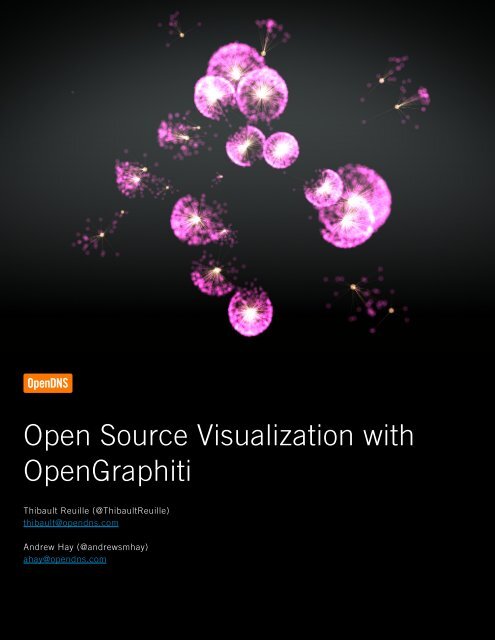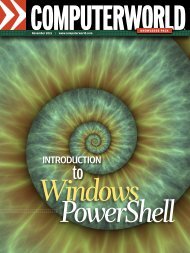Open Source Visualization with OpenGraphiti
WP-Open-Graphiti
WP-Open-Graphiti
You also want an ePaper? Increase the reach of your titles
YUMPU automatically turns print PDFs into web optimized ePapers that Google loves.
<strong>Open</strong> <strong>Source</strong> <strong>Visualization</strong> <strong>with</strong><strong>Open</strong>GraphitiThibault Reuille (@ThibaultReuille)thibault@opendns.comAndrew Hay (@andrewsmhay)ahay@opendns.com
<strong>Open</strong> <strong>Source</strong> <strong>Visualization</strong> <strong>with</strong> <strong>Open</strong>GraphitiIntroductionHumans have different ways of efficiently digesting information. Many people learnby processing visual information rather than by simply reading text. Why then,do vendors expect customers to consume data using only the written word, asopposed to advanced graphical representations of the data? We believe the writtenapproach is dated.To help data scientists, forensic analysts, incident responders, and researchers, we created a free and<strong>Open</strong> <strong>Source</strong> engine to remove the complexity of creating advanced data visualizations. The goal of the<strong>Open</strong>Graphiti project is to monitor dynamic semantic networks and pattern detection over time.With the right tools, you can take any relational dataset, quickly massage the format, and visualize theresults. Observations and conclusions can also be drawn from the results of the visualization that maynot have appeared in simple text form. The engine and methodologies discussed here have been usedat <strong>Open</strong>DNS to track CryptoLocker and CryptoDefense ransomware, Red October malware, and theKelihos botnet. Additionally, specific Syrian Electronic Army (SEA) campaigns, carding sites, and even amap of the Internet through Autonomous Systems have been visualized using <strong>Open</strong>Graphiti.Interesting data can be isolated through the use of Python and JavaScript-based plugins that canbe easily added to the engine framework. These plugins affect the way the data is visualized andallow analysts to make sense of their data as it relates to the question they’re trying to answer. The“big picture” model will help visually inclined incident responders, security analysts, and malwareresearchers stitch together complex datasets.page2
<strong>Open</strong> <strong>Source</strong> <strong>Visualization</strong> <strong>with</strong> <strong>Open</strong>GraphitiWhy Visualize the Data?Over the past few decades, the tech world has been creating robust, distributedcloud systems. Today’s data scientists are the modern oracles, discoveringingenious ways of analyzing information in order to identify new patterns andanomalies. Just like the first astronomers raised their eyes to the sky and cloudsto predict the seasons, we are constantly analyzing a deluge of digital messages tomonitor the general state of the system. It is crucial to step back, take a look at thebig picture and understand that abstraction is the key to mastering the present.A graphic organizer, also known as a knowledge map, concept map, story map, cognitive organizer,advance organizer, or concept diagram, is a communication tool that uses visual symbols to expressknowledge, concepts, thoughts, or ideas, and the relationships between them. The main purpose of agraphic organizer is to provide a visual aid to facilitate learning and instruction.According to a study conducted by The Institute for the Advancement of Research in Education at AEL 1 ,using graphic organizers improves student performance in the following areas:• Retention - Students remember information better and can better recall it when it is represented andtaught visually and verbally.• Reading comprehension - The use of graphic organizers helps improving the reading comprehensionof students.• Student achievement - Students <strong>with</strong> and <strong>with</strong>out learning disabilities improve achievement acrosscontent areas and grade levels.• Thinking and learning skills; critical thinking - When students develop and use a graphic organizertheir higher order thinking and critical thinking skills are enhanced.Some students build data literacy as they collect and explore information in a dynamic inquiry process,using tables and plots to visually investigate, manipulate, and analyze data. As students explore the waydata moves through various plot types, such as Venn, stack, pie, and axis, they formulate pathways thatlink visual images to areas that store knowledge in the brain.To show the relationships between the parts, the symbols are linked <strong>with</strong> each other; words can beused to further clarify meaning. By representing information spatially and <strong>with</strong> images, students areable to focus on meaning, reorganize and group similar ideas easily, and make better use of their visualmemory. 2This linkage model transfers very well to applied graph theory and the visualization of related datasets.12http://www.inspiration.com/sites/default/files/documents/Detailed-Summary.pdfhttp://en.wikipedia.org/wiki/Visual_learningpage3
<strong>Open</strong> <strong>Source</strong> <strong>Visualization</strong> <strong>with</strong> <strong>Open</strong>GraphitiFrom Data to <strong>Visualization</strong>When it comes to representing knowledge, semantic networks are an extremelyuseful data structure. They can be used to model nearly everything and can beapplied to a wide range of problems. But before we dig into more details, let usconsider the definition of a semantic network.A semantic network is a graph structure that represents relations between concepts. It is representedas a directed or undirected graph consisting of vertices and edges, which represent relationships.In other words, a semantic network can be represented as a graph connecting any kind of informationby any kind of relationship. From detailed to very high-level data, it is up to the user to design a modelto describe relevant and meaningful knowledge. Consider the example shown in Figure 1.Figure 1 - Example of a precise network 3 3Neiswender, C. 2011. “Semantic Network (Relational Vocabularies).” In The MMI Guides: Navigating theWorld of Marine Metadata.http://marinemetadata.org/guides/vocabs/voctypes/voccat/semanticnetworkAccessed June 30, 2014page4
<strong>Open</strong> <strong>Source</strong> <strong>Visualization</strong> <strong>with</strong> <strong>Open</strong>GraphitiTransforming Raw Data Into Relational InformationTo transform a raw data file into a relational graph, before jumping into anyscript implementation, the first thing to do is to identify the various entitiesand relationships contained in the data. The following are a few entities andrelationships that may be used:• Social Network: Facebook, Twitter, Linkedin• Nodes: People, Companies, Bands• Attributes: Name, Age, Creation Date• Edges: Friends, Couple, Employer, Fan, Subscriber• UML class diagram:• Nodes: Classes, Namespaces• Attribute: Members, Methods• Edges: Inheritance, Association, Aggregation, Dependency• Network map:• Nodes: IPs, Servers, Hosts, Routers, Firewalls• Attributes: Port, Hostname, Country• Edges: Protocol, Bandwidth, LatencyOf course, there is more than one representation for any given problem. The designers should aligntheir perspectives <strong>with</strong> the data. When the structural model has been decided, the source data shouldbe parsed to populate a relational dataset following the design.page5
<strong>Open</strong> <strong>Source</strong> <strong>Visualization</strong> <strong>with</strong> <strong>Open</strong>GraphitiVisualizing Knowledge <strong>with</strong> Force-Directed LayoutsThere are many approaches to the problem of graph visualization. One suchmethodology revolves around the use of force-directed layouts. Because themain purpose of the engine is to analyze the topology of our knowledge base, itis necessary to choose a visualization technique that will let the data drive its ownlayout.The general concept is relatively simple in that every node is treated as a particle, and every edge asa force on the particles. By implementing an engine capable of running a particle physics model wecan transform relational data, however loosely related, into a 2D or 3D structure—completely definedby the shape of the relational structure. This relational structure serves to highlight hidden clusters ortopological patterns that may have previously gone unnoticed.Discovered in 1991, the Fruchterman and Reingold layout 3 is one of the classic force-directed layouts.The main idea is to treat vertices in the graph as “atomic particles or celestial bodies, exerting attractiveand repulsive forces from one another”. This concept is depicted in Figure 2.Figure 2 - Force system concept3ftp://ftp.mathe2.uni-bayreuth.de/axel/papers/reingold:graph_drawing_by_force_directed_placement.pdfpage6
<strong>Open</strong> <strong>Source</strong> <strong>Visualization</strong> <strong>with</strong> <strong>Open</strong>GraphitiFigure 3 - Random walk diagramWhen dealing <strong>with</strong> graphs, an easy way to take random sample of a large graph is to use a RandomWalk approach. You would select random entry points in the graph and trace a random path in thegraph starting from those points, as depicted in Figure 3.There are many ways to tweak an exploration technique of this nature. It highly depends on the usermodifications and the biases involved in the selection of the random candidates —but in general, arandom walk will capture the structure of a very large graph fairly accurately.page9
<strong>Open</strong> <strong>Source</strong> <strong>Visualization</strong> <strong>with</strong> <strong>Open</strong>GraphitiParallelizationAfter every other pruning technique has been used, the remaining technique is to employparallelization. You can effectively add more computing power to a system by distributing thecalculation. This can happen remotely using Grid Computing technologies, or locally using theperformance of multiple threads, cores, or processes. However, the processing algorithm must bemodified to work in a parallel fashion, which is unfortunately not always possible.With current graphic card technology, we can take advantage of efficient graphics processing units(GPUs) and distribute the calculation across their ever-increasing number of cores and threads.GPUs are becoming exceptionally efficient at processing geometrical data such as vectors, colors,matrices, textures, or any kind of computation involving a combination of the aforementioned datatypes. Using technologies such as <strong>Open</strong> Graphics Library (<strong>Open</strong>GL) rendering, <strong>Open</strong>GL ShadingLanguage (GLSL) shaders and <strong>Open</strong> Computing Language (<strong>Open</strong>CL) physics seems like the obviouschoice to leverage the power of GPUs.Learning how to leverage GPUs (or any parallel platform) <strong>with</strong> technologies such as <strong>Open</strong>GL, GLSLand <strong>Open</strong>CL (among many others) is definitely one key to push through the theoretical barrier.Figure 4 – CPU and GPUWith <strong>Open</strong>CL for example, a task can be fully or partially distributed over several compute units.The efficiency of the whole system can then be maximized by optimizing the different parts of thealgorithm (e.g. Memory access, Instructions, and Concurrency).page 10
<strong>Open</strong> <strong>Source</strong> <strong>Visualization</strong> <strong>with</strong> <strong>Open</strong>GraphitiAbout <strong>Open</strong>GraphitiTo simplify the visualization process, we have created a tool named<strong>Open</strong>Graphiti. <strong>Open</strong>Graphiti is an open source 2D and 3D data visualizationengine for data scientists to visualize semantic networks and to work <strong>with</strong>them. It offers an easy-to-use API <strong>with</strong> several associated libraries to createcustom-made datasets. It leverages the power of GPUs to process andexplore the data and sits on a homemade 3D engine.Here is list of the technologies used:• C/C++ source code• <strong>Open</strong>GL rendering library• Python scripts• Web integration <strong>with</strong> Emscripten Javascript scripts• <strong>Open</strong>CL parallel programming library• GLSL Shaders• GLM math library• GLSL Shader• NetworkXLike any good visualization tool, data is required. In addition, the dataset must be formatted in such away that <strong>Open</strong>Graphiti can apply the algorithms to affect the spatial representation and interconnectivityof the data nodes and edges.page 11
<strong>Open</strong> <strong>Source</strong> <strong>Visualization</strong> <strong>with</strong> <strong>Open</strong>GraphitiCreation of Data FilesFigure 5 - Sample semantic graphFigure 6 - Sample code to generate a graphThis example shows how easy it is to create customized graphs. The user can define any attribute(type or other) for the nodes or edges and then connect the elements as needed. When the graph issaved (or loaded) it can be analyzed using the NetworkX graph theory library and/or combined <strong>with</strong><strong>Open</strong>Graphiti.page 12
<strong>Open</strong> <strong>Source</strong> <strong>Visualization</strong> <strong>with</strong> <strong>Open</strong>GraphitiUse Cases <strong>with</strong> <strong>Open</strong>GraphitiThere are a seemingly endless number of applicable use cases for thevisualization of loosely related data. Some examples include the analysis ofsecurity data, such as firewall, intrusion detection and prevention systems(IDS/IPS). Malware infection alerts could be visualized to expose a previouslyunrecognized patterns in a malicious actor activity, or even a misconfigurationof a technical control that allows too much, or too little, access to data, files, ornetworks.Financial analysts could, for example, analyze data to track venture investment <strong>with</strong> data points such asthe investor, the type of company being invested in (the target), its vertical market, or even the success(or failure) of the target before, during, or after the merger or acquisition. Trends may be observed tosupport a new model for investment and exit success above and beyond a simple spreadsheet.Social network analysis (SNA) can be visualized to show relationships between people and theirrelationships <strong>with</strong> other people or things. Data could be visualized to articulate the interconnectionsacross related networks in the fields of anthropology, biology, communication studies, economics,geography, history, information science, organizational studies, political science, social psychology,development studies, and sociolinguistics, among others.page 13
<strong>Open</strong> <strong>Source</strong> <strong>Visualization</strong> <strong>with</strong> <strong>Open</strong>GraphitiConclusion<strong>Open</strong>Graphiti will lower the barrier to entry for those looking to visualize complexrelated datasets. The engine will allow for the visualization of any data, howeverloosely related, in a medium that is easy to generate, navigate, and articulate.The use cases presented here only scratch the surface of what is possible. We are confident, however,that the potential may be limited only by the imagination and diligence of those leveraging the tool.Combining intelligent data mining techniques <strong>with</strong> smart data visualization is the key to betterunderstanding the complex problems we are trying to solve. To take a significant step in the monitoringand managing of a large-scale state machine in constant evolution, passive introspection is not enough.It is necessary to build an interface that acts on the system through manual or algorithmic modification.By presenting and open-sourcing <strong>Open</strong>Graphiti, we hope to put in place the first blocks in thefoundation of a next-generation data analysis tool. The goal is to surfacing new techniques to build alarge-scale, distributed, and graph-based data monitoring system.Documentation and source code for <strong>Open</strong>Graphiti will be made available via GitHub at:https://github.com/opendns/datavizpage 14
<strong>Open</strong> <strong>Source</strong> <strong>Visualization</strong> <strong>with</strong> <strong>Open</strong>GraphitiReferencesRepositoriesPapers<strong>Open</strong>Graphitihttps://github.com/opendns/datavizSemanticNethttps://github.com/ThibaultReuille/semanticnetNetworkXhttps://networkx.github.io/<strong>Open</strong>Graphiti Devhttps://github.com/ThibaultReuille/graphitiRaindancehttps://github.com/ThibaultReuille/raindance“Force-Directed Drawing Algorithms”http://cs.brown.edu/~rt/gdhandbook/chapters/force-directed.pdf“<strong>Open</strong>GL Shading Language”http://www.opengl.org/documentation/glsl/“Graphic Organizers: A Review of ScientificallyBased Research”http://www.inspiration.com/sites/default/files/documents/Detailed-Summary.pdfSOFTWARE—PRACTICE AND EXPERIENCE,VOL. 21(1 1), 1129-1164 (NOVEMBER 1991)Graph Drawing by Force-directed PlacementTHOMAS M. J. FRUCHTERMAN* AND EDWARDM. REINGOLDftp://ftp.mathe2.uni-bayreuth.de/axel/papers/reingold:graph_drawing_by_force_directed_placement.pdfpage 15
<strong>Open</strong>DNS provides a cloud-delivered network securityservice that delivers automated protection againstadvanced attacks for any device, anywhere.Visit www.opendns.com/enterprise-securityto Instantly Start a Free 2-Week Trial<strong>Open</strong>DNS, Inc.www.opendns.com1.877.811.2367Copyright @2014 <strong>Open</strong>DNS, Inc. All rights reserved worldwide. No part ofthis document may be reproduced by any means nor translated to any electricmedium <strong>with</strong>out the written consent of <strong>Open</strong>DNS, Inc. Information contained inthis document is believed to be accurate and reliable, however, <strong>Open</strong>DNS, Inc.assumes no responsibility for its use.




